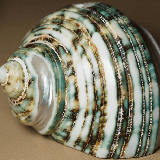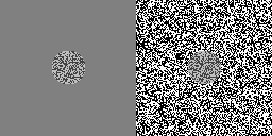
The visual cortex of the brain is that part of the cerebral cortex which processes visual information. It is located in the occipital lobe. Visual nerves run straight from the eye to the primary visual cortex to the Visual Association cortex.
A tactile illusion is an illusion that affects the sense of touch. Some tactile illusions require active touch, whereas others can be evoked passively. In recent years, a growing interest among perceptual researchers has led to the discovery of new tactile illusions and to the celebration of tactile illusions in the popular science press. Some tactile illusions are analogous to visual and auditory illusions, suggesting that these sensory systems may process information in similar ways; other tactile illusions don't have obvious visual or auditory analogs.
The McCollough effect is a phenomenon of human visual perception in which colorless gratings appear colored contingent on the orientation of the gratings. It is an aftereffect requiring a period of induction to produce it. For example, if someone alternately looks at a red horizontal grating and a green vertical grating for a few minutes, a black-and-white horizontal grating will then look greenish and a black-and-white vertical grating will then look pinkish. The effect is remarkable because, under certain circumstances, it can last up to three months or more.

Motion perception is the process of inferring the speed and direction of elements in a scene based on visual, vestibular and proprioceptive inputs. Although this process appears straightforward to most observers, it has proven to be a difficult problem from a computational perspective, and extraordinarily difficult to explain in terms of neural processing.
Multisensory integration, also known as multimodal integration, is the study of how information from the different sensory modalities, such as sight, sound, touch, smell, self-motion and taste, may be integrated by the nervous system. A coherent representation of objects combining modalities enables us to have meaningful perceptual experiences. Indeed, multisensory integration is central to adaptive behavior because it allows us to perceive a world of coherent perceptual entities. Multisensory integration also deals with how different sensory modalities interact with one another and alter each other's processing.

The Hering illusion is one of the geometrical-optical illusions and was discovered by the German physiologist Ewald Hering in 1861. When two straight and parallel lines are presented in front of radial background, the lines appear as if they were bowed outwards. The Orbison illusion is one of its variants, while the Wundt illusion produces a similar, but inverted effect.
Neuronal tuning refers to the hypothesized property of brain cells by which they selectively represent a particular type of sensory, association, motor, or cognitive information. Some neuronal responses have been hypothesized to be optimally tuned to specific patterns through experience. Neuronal tuning can be strong and sharp, as observed in primary visual cortex, or weak and broad, as observed in neural ensembles. Single neurons are hypothesized to be simultaneously tuned to several modalities, such as visual, auditory, and olfactory. Neurons hypothesized to be tuned to different signals are often hypothesized to integrate information from the different sources. In computational models called neural networks, such integration is the major principle of operation. The best examples of neuronal tuning can be seen in the visual, auditory, olfactory, somatosensory, and memory systems, although due to the small number of stimuli tested the generality of neuronal tuning claims is still an open question.

The two-streams hypothesis is a model of the neural processing of vision as well as hearing. The hypothesis, given its initial characterisation in a paper by David Milner and Melvyn A. Goodale in 1992, argues that humans possess two distinct visual systems. Recently there seems to be evidence of two distinct auditory systems as well. As visual information exits the occipital lobe, and as sound leaves the phonological network, it follows two main pathways, or "streams". The ventral stream is involved with object and visual identification and recognition. The dorsal stream is involved with processing the object's spatial location relative to the viewer and with speech repetition.

In mathematics, physics, and engineering, spatial frequency is a characteristic of any structure that is periodic across position in space. The spatial frequency is a measure of how often sinusoidal components of the structure repeat per unit of distance. The SI unit of spatial frequency is cycles per meter. In image-processing applications, spatial frequency is often expressed in units of cycles per millimeter or equivalently line pairs per millimeter.
The kappa effect or perceptual time dilation is a temporal perceptual illusion that can arise when observers judge the elapsed time between sensory stimuli applied sequentially at different locations. In perceiving a sequence of consecutive stimuli, subjects tend to overestimate the elapsed time between two successive stimuli when the distance between the stimuli is sufficiently large, and to underestimate the elapsed time when the distance is sufficiently small.
In human perception, contingent aftereffects are illusory percepts that are apparent on a test stimulus after exposure to an induction stimulus for an extended period. Contingent aftereffects can be contrasted with simple aftereffects, the latter requiring no test stimulus for the illusion/mis-perception to be apparent. Contingent aftereffects have been studied in different perceptual domains. For instance, visual contingent aftereffects, auditory contingent aftereffects and haptic contingent aftereffects have all been discovered.
Akinetopsia, also known as cerebral akinetopsia or motion blindness, is a neuropsychological disorder in which a patient cannot perceive motion in their visual field, despite being able to see stationary objects without issue. There are varying degrees of akinetopsia: from seeing motion as a cinema reel to an inability to discriminate any motion. There is currently no effective treatment or cure for akinetopsia.

The Chubb illusion is an optical illusion or error in visual perception in which the apparent contrast of an object varies substantially to most viewers depending on its relative contrast to the field on which it is displayed. These visual illusions are of particular interest to researchers because they may provide valuable insights in regard to the workings of human visual systems.

A hypercomplex cell is a type of visual processing neuron in the mammalian cerebral cortex. Initially discovered by David Hubel and Torsten Wiesel in 1965, hypercomplex cells are defined by the property of end-stopping, which is a decrease in firing strength with increasingly larger stimuli. The sensitivity to stimulus length is accompanied by selectivity for the specific orientation, motion, and direction of stimuli. For example, a hypercomplex cell may only respond to a line at 45˚ that travels upward. Elongating the line would result in a proportionately weaker response. Ultimately, hypercomplex cells can provide a means for the brain to visually perceive corners and curves in the environment by identifying the ends of a given stimulus.
Object recognition is the ability to perceive an object's physical properties and apply semantic attributes to it. This process includes the understanding of its use, previous experience with the object, and how it relates to others. Regardless of an object's position or illumination, humans possess the ability to effectively identify and label an object. Humans are one of the few species that possess the ability of invariant visual object recognition. Both "front end" and "back end" processing are required for a species to be able to recognize objects at varying distances, angles, lighting, etc....
Chronostasis is a type of temporal illusion in which the first impression following the introduction of a new event or task-demand to the brain can appear to be extended in time. For example, chronostasis temporarily occurs when fixating on a target stimulus, immediately following a saccade. This elicits an overestimation in the temporal duration for which that target stimulus was perceived. This effect can extend apparent durations by up to 500 ms and is consistent with the idea that the visual system models events prior to perception.

A phantom contour is a type of illusory contour. Most illusory contours are seen in still images, such as the Kanizsa triangle and the Ehrenstein illusion. A phantom contour, however, is perceived in the presence of moving or flickering images with contrast reversal. The rapid, continuous alternation between opposing, but correlated, adjacent images creates the perception of a contour that is not physically present in the still images.
Binocular neurons are neurons in the visual system that assist in the creation of stereopsis from binocular disparity. They have been found in the primary visual cortex where the initial stage of binocular convergence begins. Binocular neurons receive inputs from both the right and left eyes and integrate the signals together to create a perception of depth.
Surround suppression is where the relative firing rate of a neuron may under certain conditions decrease when a particular stimulus is enlarged. It is has been observed in electrophysiology studies of the brain and has been noted in many sensory neurons, most notably in the early visual system. Surround suppression is defined as a reduction in the activity of a neuron in response to a stimulus outside its classical receptive field. note, quoting Kuffler (1953), "not only the areas from which responses can actually be set up by retinal illumination may be included in a definition of the receptive field but also all areas which show a functional connection, by an inhibitory or excitatory effect on a ganglion cell." The necessary functional connections with other neurons influenced by stimulation outside a particular area and by dynamic processes in general, and the absence of a theoretical description of a system state to be treated as a baseline, deprive the term "classical receptive field" of functional meaning. The descriptor "surround suppression" suffers from a similar problem, as the activities of neurons in the "surround" of the "classical receptive field are similarly determined by connectivities and processes involving neurons beyond it.) This nonlinear effect is one of many that reveals the complexity of biological sensory systems, and the connections of properties of neurons that may cause this effect are still being studied. The characteristics, mechanisms, and perceptual consequences of this phenomenon are of interest to many communities, including neurobiology, computational neuroscience, psychology, and computer vision.

Serotonin (5-hydroxytryptamine) is a monoamine neurotransmitter that plays a role in mood, eating, sleeping, arousal and potentially visual orientation processing. To investigate its function in visual orientation, researchers have utilised MDMA, or as it is commonly referred to, Ecstasy (3,4-methylenedioxymethamphetamine). MDMA is known to affect serotonin neurons in the brain and cause neurotoxicity. Serotonin has been hypothesised to be involved in visual orientation because individuals who use MDMA exhibit an increase in the magnitude of the tilt aftereffect (TAE). The TAE is a visual illusion where viewing lines in one direction, for an extended period of time, produces the perception of a tilt in the opposite direction to vertical lines subsequently viewed. This effect is proposed to occur due to lateral inhibition to orientation sensitive neurons in the occipital lobe. Lateral inhibition is where neurons that become activated to a particular orientation send inhibitory signals to their neighbouring neurons. The degree of orientation that each neuron becomes maximally excited to is referred to as the tuning bandwidth. Lateral inhibition consequently plays a pivotal role in each neuron's tuning bandwidth, such that if lateral inhibition no longer occurs, a greater number of neurons will become stimulated to the same orientation. This results in the activated neurons becoming adapted to the same orientation stimulus, if the stimulus is viewed for a period of time. As a consequence, if those neurons are subsequently 'shown' another stimulus that differs slightly in its orientation, those neurons are no longer able to achieve the same level of response as compared to other non-adapted neurons.










